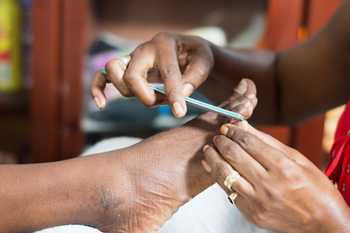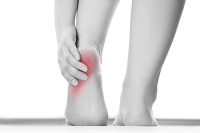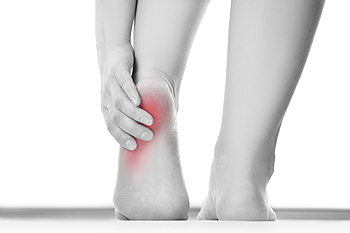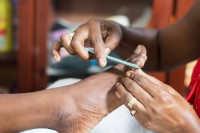
Blog (817)
Care In The Comfort Of Your Home With Telehealth
Care In The Comfort Of Your Home With Telehealth
Arthritis Can Cause Pain in the Feet and Ankles
Heel Pain Fast Facts
Heel pain is extremely common and is typically caused by small, repetitive injuries to the heel over time. Most heel pain is localized under and in front of the heel, although pain can also affect the back of the heel and can sometimes radiate to, or from, the arch of the foot or the ankle. Heel pain typically starts gradually and may worsen over time when left untreated. Potential causes of heel pain can include plantar fasciitis, heel bursitis, heel spurs, tarsal tunnel syndrome, heel pad inflammation, Sever’s disease, stress fractures, and Achilles tendonitis. Fortunately, conservative treatment methods such as resting, icing, compressing, and elevating the affected foot, as well as wearing supportive shoes and taking over-the-counter pain medications can help with pain and swelling, but may not be a permanent solution. If you are experiencing any type of heel pain, it is strongly suggested that you consult with a podiatrist to receive a proper diagnosis with a corresponding treatment plan.
Many people suffer from bouts of heel pain. For more information, contact Dr. Kenneth Donovan of Advanced Care Foot and Ankle. Our doctor can provide the care you need to keep you pain-free and on your feet.
Causes of Heel Pain
Heel pain is often associated with plantar fasciitis. The plantar fascia is a band of tissues that extends along the bottom of the foot. A rip or tear in this ligament can cause inflammation of the tissue.
Achilles tendonitis is another cause of heel pain. Inflammation of the Achilles tendon will cause pain from fractures and muscle tearing. Lack of flexibility is also another symptom.
Heel spurs are another cause of pain. When the tissues of the plantar fascia undergo a great deal of stress, it can lead to ligament separation from the heel bone, causing heel spurs.
Why Might Heel Pain Occur?
- Wearing ill-fitting shoes
- Wearing non-supportive shoes
- Weight change
- Excessive running
Treatments
Heel pain should be treated as soon as possible for immediate results. Keeping your feet in a stress-free environment will help. If you suffer from Achilles tendonitis or plantar fasciitis, applying ice will reduce the swelling. Stretching before an exercise like running will help the muscles. Using all these tips will help make heel pain a condition of the past.
If you have any questions please contact one of our offices located in Warren, Livingston, and Toms River, NJ . We offer the newest diagnostic and treatment technologies for all your foot and ankle needs.
Helpful Tips for Maintaining the Health of Your Feet
Many people take their feet for granted, despite their importance despite the fact they are the foundation of the body. There are simple techniques that can improve the overall health of your feet which will have a positive effect on the rest of your body. These helpful tips can include washing and drying the feet thoroughly every day, followed by applying a good moisturizer. When the toes are trimmed properly, painful foot conditions such as ingrown toenails may be prevented. Maintaining a hygiene routine for your feet may play a significant role in preventing athlete's foot, which can make the feet feel itchy and uncomfortable. If you would like additional information about the importance of practicing everyday foot care techniques, it is suggested that you consult with a podiatrist.
Everyday foot care is very important to prevent infection and other foot ailments. If you need your feet checked, contact Dr. Kenneth Donovan from Advanced Care Foot and Ankle. Our doctor can provide the care you need to keep you pain-free and on your feet.
Everyday Foot Care
Often, people take care of their bodies, face and hair more so than they do for their feet. But the feet are a very important aspect of our bodies, and one that we should pay more attention to. Without our feet, we would not be able to perform most daily tasks.
It is best to check your feet regularly to make sure there are no new bruises or cuts that you may not have noticed before. For dry feet, moisturizer can easily be a remedy and can be applied as often as necessary to the affected areas. Wearing shoes that fit well can also help you maintain good foot health, as well as making it easier to walk and do daily activities without the stress or pain of ill-fitting shoes, high heels, or even flip flops. Wearing clean socks with closed shoes is important to ensure that sweat and bacteria do not accumulate within the shoe. Clean socks help to prevent Athlete’s foot, fungi problems, bad odors, and can absorb sweat.
If you have any questions please feel free to contact one of our offices located in Warren, Livingston, and Toms River, NJ . We offer the newest diagnostic and treatment technologies for all your foot and ankle needs.
Helpful Tips for Maintaining the Health of Your Feet
 Many people take their feet for granted, despite their importance despite the fact they are the foundation of the body. There are simple techniques that can improve the overall health of your feet which will have a positive effect on the rest of your body. These helpful tips can include washing and drying the feet thoroughly every day, followed by applying a good moisturizer. When the toes are trimmed properly, painful foot conditions such as ingrown toenails may be prevented. Maintaining a hygiene routine for your feet may play a significant role in preventing athlete's foot, which can make the feet feel itchy and uncomfortable. If you would like additional information about the importance of practicing everyday foot care techniques, it is suggested that you consult with a podiatrist.
Many people take their feet for granted, despite their importance despite the fact they are the foundation of the body. There are simple techniques that can improve the overall health of your feet which will have a positive effect on the rest of your body. These helpful tips can include washing and drying the feet thoroughly every day, followed by applying a good moisturizer. When the toes are trimmed properly, painful foot conditions such as ingrown toenails may be prevented. Maintaining a hygiene routine for your feet may play a significant role in preventing athlete's foot, which can make the feet feel itchy and uncomfortable. If you would like additional information about the importance of practicing everyday foot care techniques, it is suggested that you consult with a podiatrist.
Everyday foot care is very important to prevent infection and other foot ailments. If you need your feet checked, contact Dr. Kenneth Donovan from Advanced Care Foot and Ankle. Our doctor can provide the care you need to keep you pain-free and on your feet.
Everyday Foot Care
Often, people take care of their bodies, face and hair more so than they do for their feet. But the feet are a very important aspect of our bodies, and one that we should pay more attention to. Without our feet, we would not be able to perform most daily tasks.
It is best to check your feet regularly to make sure there are no new bruises or cuts that you may not have noticed before. For dry feet, moisturizer can easily be a remedy and can be applied as often as necessary to the affected areas. Wearing shoes that fit well can also help you maintain good foot health, as well as making it easier to walk and do daily activities without the stress or pain of ill-fitting shoes, high heels, or even flip flops. Wearing clean socks with closed shoes is important to ensure that sweat and bacteria do not accumulate within the shoe. Clean socks help to prevent Athlete’s foot, fungi problems, bad odors, and can absorb sweat.
If you have any questions please feel free to contact one of our offices located in Warren, Livingston, and Toms River, NJ . We offer the newest diagnostic and treatment technologies for all your foot and ankle needs.
Do Parents Understand Their Children’s Foot Development?
 There are many parents that are concerned with the development of their children’s feet. This can range from when to purchase their first pair of shoes, to observing foot conditions that may have developed. There are studies that have been performed that have shown parents understand the importance of having their children walking barefoot while indoors. This can be beneficial in strengthening the entire foot as the toes grip the floor. Additionally, measuring the feet frequently is helpful in determining what size shoe is perfect for their feet. Additionally, many parents choose the type of shoes based on price, and what the shoes will be worn for, including school or play. If you would like more information about children’s foot development at specific ages, please schedule an appointment with a podiatrist.
There are many parents that are concerned with the development of their children’s feet. This can range from when to purchase their first pair of shoes, to observing foot conditions that may have developed. There are studies that have been performed that have shown parents understand the importance of having their children walking barefoot while indoors. This can be beneficial in strengthening the entire foot as the toes grip the floor. Additionally, measuring the feet frequently is helpful in determining what size shoe is perfect for their feet. Additionally, many parents choose the type of shoes based on price, and what the shoes will be worn for, including school or play. If you would like more information about children’s foot development at specific ages, please schedule an appointment with a podiatrist.
Making sure that your children maintain good foot health is very important as they grow. If you have any questions, contact Dr. Kenneth Donovan of Advanced Care Foot and Ankle. Our doctor can provide the care you need to keep you pain-free and on your feet.
Keeping Children's Feet Healthy
Having healthy feet during childhood can help prevent medical problems later in life, namely in the back and legs. As children grow, their feet require different types of care. Here are some things to consider...
Although babies do not walk yet, it is still very important to take care of their feet.
Avoid putting tight shoes or socks on his or her feet.
Allow the baby to stretch and kick his or her feet to feel comfortable.
As a toddler, kids are now on the move and begin to develop differently. At this age, toddlers are getting a feel for walking, so don’t be alarmed if your toddler is unsteady or ‘walks funny’.
As your child gets older, it is important to teach them how to take care of their feet.
Show them proper hygiene to prevent infections such as fungus.
Be watchful for any pain or injury.
Have all injuries checked by a doctor as soon as possible.
Comfortable, protective shoes should always be worn, especially at play.
If you have any questions please feel free to contact one of our offices located in Warren, Livingston, and Toms River, NJ . We offer the newest diagnostic and treatment technologies for all your foot and ankle needs.
Arthritis Can Cause Pain in the Feet and Ankles
Flip Flops Are Not Friendly to Your Feet
Flip flops may be an easy, breezy accessory for warm weather, but there are many reasons why they are not good for your feet. They offer little to no support or cushioning which can lead to heel pain and problems with your Achilles tendons. You are more likely to trip wearing flip flops, and they can lead to tired, achy feet. They offer no protection from injuries or sun exposure. The worst part is that they can change your foot biomechanics and posture. Your toe muscles need to continuously grip them to keep them on, and they shorten your gait and turn your ankles inward. Contact a podiatrist if you have any pain, instability, or other problems in your feet or ankles caused by flip flops.
Flip-flops are not always the best choice of footwear. If you have any concerns about your feet or ankles, contact Dr. Kenneth Donovan from Advanced Care Foot and Ankle. Our doctor will assist you with all of your foot and ankle needs.
Flip-Flops and Feet
When the weather starts warming up, people enjoy wearing flip-flops. Flip-flops are comfortable, stylish, and easy to slip on and off; they're perfect for any summer beach goer. However, these shoes can cause harm to the feet.
How Can Flip-Flops Affect Me Long-Term?
- Ankle problems
- Hip problems
- Lower back problems
- Pain in the balls of the feet
- Problems with foot arches
- Changes in the way you walk
Are There Injuries Associated with Flip-Flops?
Yes. Since flip-flops are relatively weak and do not provide the same amount of support as sneakers, people who wear flip-flops regularly are more susceptible to injuries. On top of that, the open nature of the shoe makes your feet more prone to other problems, such as cuts and even infections. Common injuries and ailments include:
- Sprained ankles
- Blisters
- Infections
- Cuts and Scrapes
I like Wearing Flip-Flops. Are There Safe Alternatives?
When buying flip-flops, try to find ones that have sturdy soles and that are made of high-quality materials that will support for your feet. These flip-flops will cost more but will also last longer as a result.
If you have any questions please feel free to contact one of our offices located in Warren, Livingston, and Toms River, NJ . We offer the newest diagnostic and treatment technologies for all your foot and ankle needs.
Ankle Sprains: A Very Common Injury
When the ligaments that connect and support the ankle joint get stretched or torn during a physical activity or accident, an ankle sprain may occur. Ankle sprains are very common and are often recurrent because they sometimes go untreated, and therefore don’t heal properly. You may sprain your ankle while running or walking on uneven surfaces, making sudden movements or landing wrong after a jump during sports, or twisting your ankle wearing high heels. Ankle sprains are graded in severity from 1-3 with symptoms such as pain, bruising, swelling, instability, tenderness, and limitation of movement. If you believe you have sprained your ankle, contact a podiatrist who can properly diagnose you and use a variety of methods such as RICE (rest-ice-compression-elevation), bracing, physical therapy, medication and more to treat your ankle sprain and to help avoid chronic ankle instability.
Ankle pain can be caused by a number of problems and may be potentially serious. If you have ankle pain, consult with Dr. Kenneth Donovan from Advanced Care Foot and Ankle. Our doctor will assess your condition and provide you with quality foot and ankle treatment.
Ankle pain is any condition that causes pain in the ankle. Due to the fact that the ankle consists of tendons, muscles, bones, and ligaments, ankle pain can come from a number of different conditions.
Causes
The most common causes of ankle pain include:
- Types of arthritis (rheumatoid, osteoarthritis, and gout)
- Ankle sprains
- Broken ankles
- Achilles tendinitis
- Achilles tendon rupture
- Stress fractures
- Bursitis
- Tarsal tunnel syndrome
- Plantar fasciitis
Symptoms
Symptoms of ankle injury vary based upon the condition. Pain may include general pain and discomfort, swelling, aching, redness, bruising, burning or stabbing sensations, and/or loss of sensation.
Diagnosis
Due to the wide variety of potential causes of ankle pain, podiatrists will utilize a number of different methods to properly diagnose ankle pain. This can include asking for personal and family medical histories and of any recent injuries. Further diagnosis may include sensation tests, a physical examination, and potentially x-rays or other imaging tests.
Treatment
Just as the range of causes varies widely, so do treatments. Some more common treatments are rest, ice packs, keeping pressure off the foot, orthotics and braces, medication for inflammation and pain, and surgery.
If you have any questions, please feel free to contact one of our offices located in Warren, Livingston, and Toms River, NJ . We offer the newest diagnostic and treatment technologies for all your foot care needs.














